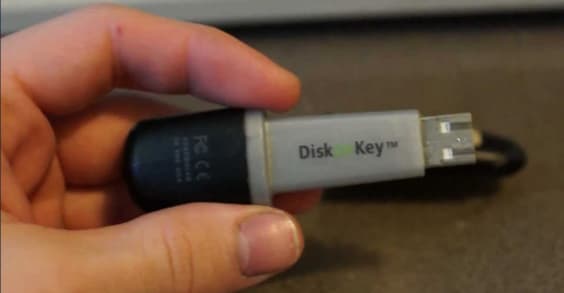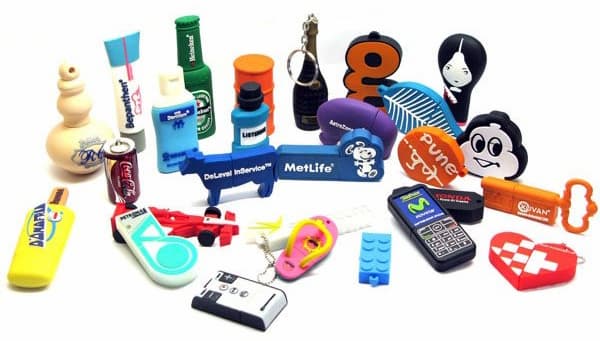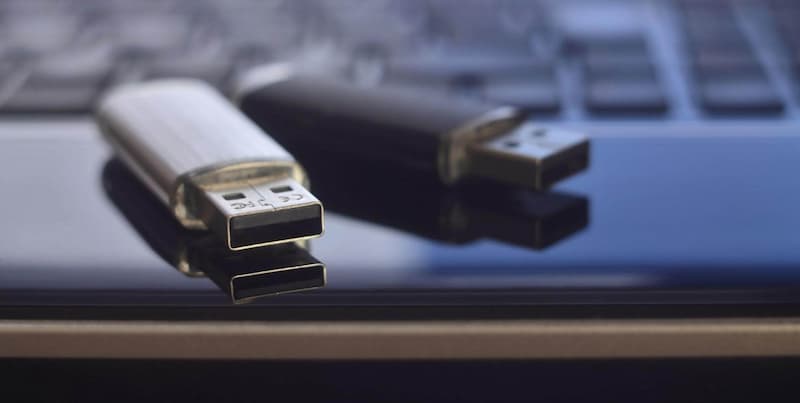
12 February, 2024
A Flash from the Past: The Evolution of USB Drives as Promo Items
In an age where cloud storage and digital downloads are omnipresent, one might think that physical storage devices like USB drives would become obsolete. However, they've stood the test of time and have even become popular for promotional items. Whether you're attending a trade show or a corporate event, chances are you'll walk away with a branded USB drive. But how did we get here? It's a fascinating evolution of USB drives as promotional items, so let's look at their history, utility, and how they've adapted to fit the needs of modern marketing.

The Humble Beginnings
When the Universal Serial Bus (USB) drive was first introduced in the late 1990s, it revolutionised the way data was stored and transferred. Before the advent of the USB drive, options for data storage and transfer were either unwieldy, like floppy disks, or complicated, requiring various cables and connections. The USB drive simplified all of this into a small, plug-and-play device that could easily fit into your pocket.
These tiny devices were initially hailed for their primary data storage and transfer functions, but it didn't take long for businesses to recognise their broader potential. Here was a piece of technology that virtually every professional needed, presenting an unprecedented opportunity for brand visibility. Unlike traditional marketing materials, such as brochures or pens, USB drives had an innate utility that ensured they would be used repeatedly, increasing brand exposure each time they were plugged into a computer.
Moreover, the late '90s were a period of booming technological growth. Computers were becoming household items, and the internet was opening new avenues for business. Companies were eager to adopt the latest technologies, and the USB drive was at the forefront of this movement. By branding them and distributing them as corporate gifts or at trade shows, businesses could align themselves with innovation and practicality, attributes that were highly valued at the time.
First Wave of Promotional Use
The early 2000s represented a pivotal period in the realm of promotional use. As businesses were rapidly digitising and internet usage was becoming more ubiquitous, traditional marketing materials like brochures and business cards were starting to seem somewhat dated. Companies were in search of new, innovative ways to catch the eyes of potential clients and partners, and the USB drive perfectly fitted the bill.
Businesses began replacing or supplementing the old-fashioned printed materials with branded USB drives. They were often pre-loaded with a wealth of digital information, including anything from product catalogues and technical specifications to multimedia presentations and sales pitches. The idea was to provide something that was not only useful in itself - a reusable data storage device - but also served as a direct marketing tool.
This was an era when CD-ROMs were starting to be seen as cumbersome, and the idea of providing valuable information in a portable, reusable format was seen as cutting-edge. The fact that these were also far less likely to be immediately discarded, unlike a brochure or a leaflet, added to their appeal. They became keepsakes, often finding their way onto keyrings or living in laptop bags for years, continuing to serve their function and remind users of the brand emblazoned on them.
Moreover, tech gadgets' "cool factor" in the early 2000s cannot be underestimated. Owning a USB drive was still somewhat of a novelty, and having one—especially one received as a free gift—signalled that you were ahead of the curve. Businesses that chose to use them for promotional purposes were similarly seen as innovative and forward-thinking.
The early 2000s also saw the cost of manufacturing fall significantly, making it a more feasible option for companies with tighter marketing budgets. As a result, smaller businesses and startups began to jump on the bandwagon, further solidifying it's status as a preferred promotional item.

Advancements in Customisation
By the late 2000s, the landscape of promotional items had evolved, and with it, the possibilities for customising USB drives had greatly expanded. Advancements in manufacturing technologies like 3D printing and improved moulding techniques ushered in a new level of customisation that went beyond mere logos or text.
The standard rectangular or 'stick' form, which had been the norm for many years, began giving way to many creative designs. Businesses could now literally 'shape' their marketing campaigns. This meant that a cosmetics company could distribute them shaped like lipsticks, a car manufacturer could have drives moulded into miniature models of their latest offering, and a fast-food chain could produce them resembling their signature menu items.
Custom colours also became more accessible. Pantone matching systems allowed companies to get the exact hue representing their corporate colours, ensuring brand consistency across this and other promotional items. Not only did this add another layer of brand recognition, but it also allowed the companies to align their marketing materials closely with their overall brand image.
In addition to external customisations, the contents stored within them became more sophisticated. Auto-run features could be configured to launch a promotional video or redirect to a specific webpage upon insertion into a computer, thereby making the user experience more interactive and engaging. Companies also started to pre-load drives with a variety of multimedia content, including interactive presentations and software trials, offering a richer experience than the text documents and PDFs of earlier promotional drives.
This advancement in customisation allowed brands to better connect with their target audience on both a functional and emotional level. A custom-shaped USB drive wasn't just a tool but a conversation starter, a tangible representation of what a brand was about. It offered an immediate visual impact, capturing attention in a way that a standard one never could.
So, the late 2000s didn't just bring customisation improvements; they revolutionised how they were used in promotional marketing. Brands could now create truly unique items that resonated deeply with their audience, bolstering recall and engagement.
Multi-Functionality
By the time the 2010s rolled around, they had matured from mere data storage devices to multi-functional tools, greatly increasing their allure as promotional items. The integration of additional features aimed to add layers of utility, pushing the boundaries of what a simple USB drive could achieve.
One popular adaptation was the USB pen, a seamless amalgamation of a writing instrument and a storage device. Not only could you write down your notes in a meeting, but you could also save a digital copy of the minutes right then and there. This dual functionality made it a go-to giveaway at corporate events, particularly beneficial for professionals who appreciated the efficiency of having a pen and storage device in one.
Another innovative variant was the USB drive-cum-bottle opener. Initially seen as a bit of a novelty, it quickly gained traction in casual and social settings. Imagine being at a barbecue or a camping trip; the usefulness of having a bottle opener that also carries your favourite playlist is hard to overstate. Such styles proved particularly popular at lifestyle events, festivals, or as part of product launches in the food and beverage sector.
One with an integrated torch also made an appearance, combining data storage with a practical light source. This was a hit among outdoor enthusiasts and adventure-seekers, and even as a safety item in emergency kits. The added functionality of illumination appealed to a demographic that required practicality from their gadgets, and companies in the automotive, outdoor gear, and safety sectors found them to be particularly effective promotional items.
Their multi-functional use was not just about adding bells and whistles; they were about enriching the user experience by making it more versatile. Each added function served to enhance its appeal, transforming it from a single-use item into a Swiss Army knife of possibilities. This multi-functionality increased the perceived value and increased the likelihood of it being used regularly, thus magnifying the promotional impact.

The Role of Pre-Loaded Content
In the realm of modern marketing, pre-loaded content has become a sophisticated strategy to engage a target audience more deeply than ever before. Unlike the early 2000s, when the content was often static and limited to PDFs or simple text files, today's pre-loaded styles offer a dynamic interactive experience.
For instance, businesses can now include videos that offer a visual and auditory experience, elevating the marketing message to a whole new level. These could be company introductions, product demonstrations, or testimonials that automatically play upon insertion. These videos can quickly grab attention and make a lasting impression, something static text or images struggle to achieve.
Interactive catalogues are another leap forward. Imagine opening a pre-loaded USB to find a catalogue where you can click on products to get more information, view videos, or even be directed to an e-commerce page to make an immediate purchase. This interactive element not only serves to engage the user more effectively but also provides a seamless transition from marketing to sales, all encapsulated in one tiny device.
Links to private web portals add yet another layer of engagement. These can offer exclusive access to resources, special offers, or further in-depth material that wouldn't be available to the general public. It creates a sense of exclusivity and value, fostering a closer relationship between the brand and the consumer.
Also, the pre-loaded content can be tailored to specific industries or customer profiles. For instance, a pharmaceutical company might include technical white papers or research data relevant to healthcare professionals, whereas a video game developer might preload trailers or exclusive behind-the-scenes content targeted at gaming enthusiasts.
The very act of plugging one in and discovering a rich world of pre-loaded content turns into an exploratory experience, a digital journey that each user undertakes. This makes it not just a carrier of a brand logo but an entire brand experience. By providing valuable, engaging, and tailored content, companies are using this humble device to forge stronger connections with their audience, making it a highly effective tool in contemporary marketing arsenals.
The Future of Promotional USB Drives
In an era where cloud computing and wireless data transfer are becoming the norm, they may seem to be an artefact of a bygone age. However, that's far from the case. The persistent allure of these compact storage devices lies in their ability to adapt and offer something novel, even in the face of advancing technology.
One significant trend shaping the future is the emphasis on high-quality, high-capacity devices. Gone are the days when a 1GB or 2GB drive was sufficient. Businesses are now investing in premium drives boasting 64GB, 128GB, or even higher capacities. These spacious drives meet the demands of today's digital landscape, where file sizes—be it for high-definition videos, extensive software, or large data sets—are continually increasing.
High-capacity drives are not just about more space; they're also about speed. The introduction of USB 3.0 and 3.1 technologies has made faster data transfer rates a reality. This is a critical selling point for tech-savvy consumers and professionals who are constantly transferring large files and cannot afford to waste time. By offering them with these advanced features, companies make a statement about their forward-thinking attitude and understanding of consumer needs, making their promotional item more desirable and useful.
The shift towards premium ones is a conscious move to make these items enduring rather than disposable. A high-quality, high-capacity, fast one is more likely to be retained and used regularly, reinforcing brand visibility and consumer loyalty. In essence, their future is not in their obsolescence but in their evolution into a more robust, efficient, and lasting product.
In summary, their future looks promising despite the onset of cloud computing and wireless data transfer technologies. Their enduring appeal will likely stem from their ability to adapt—offering higher capacities, faster transfer rates, and ultimately a product that continues to be both useful and desirable. Far from fading into obscurity, promotional USB drives are geared up to remain a key player in the branded merchandise landscape.
Summary
They have come a long way from their humble origins to their current status as multifunctional, customisable, and even eco-friendly promotional items. They continue to offer an effective means of reaching a broad audience, delivering both practical utility and brand messaging in a single, compact package. With ongoing advancements in technology and design, the journey of USB drives as promotional items is far from over.
The Custom USB Drives Team




